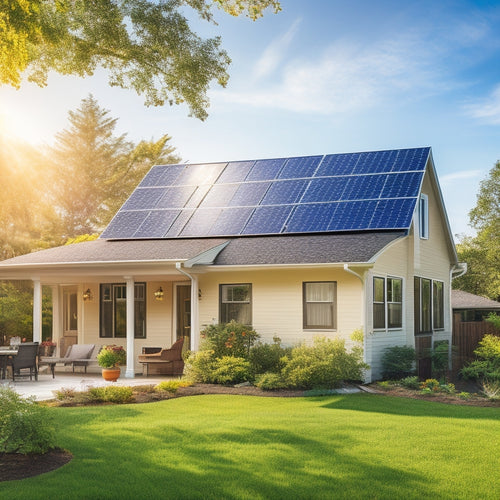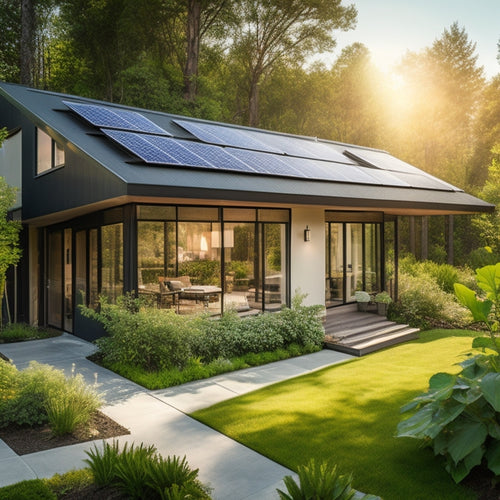
Is Your Business Ready for Solar Panel Installation
Share
You're considering solar panel installation for your business, but are you truly ready? Assess your energy needs by reviewing past bills to identify peak usage periods and optimize energy consumption patterns. Evaluate your roof's condition and structural integrity to guarantee it can support the panels. Understand local incentives, such as tax credits, and determine the required system size. Additionally, consider energy storage options, financial benefits, and compliance with local building codes. Finally, plan for ongoing maintenance. By addressing these key factors, you'll be well-prepared for a successful solar panel installation that meets your business's unique needs - and that's just the beginning of your expedition towards utilizing renewable energy.
Key Takeaways
- Assess energy needs and system requirements through energy consumption analysis and system sizing to ensure optimal installation.
- Evaluate roof condition and structural integrity to ensure a secure and compatible installation site.
- Identify and address potential obstacles, such as storm damage, vents, and skylights, to ensure a smooth installation process.
- Understand local incentives, financial benefits, and energy storage considerations to maximize the return on investment.
- Develop a comprehensive maintenance plan, including performance monitoring and regular inspections, to ensure system longevity and efficiency.
Assessing Your Energy Needs
Many businesses consume a substantial amount of energy to power their operations, and understanding your energy needs is essential in determining the feasibility of solar panel installation.
You need to assess your energy consumption trends to identify areas where you can optimize energy usage. This involves reviewing your past energy bills to determine your peak energy usage periods and analyzing your energy consumption patterns.
Evaluating Your Roof's Condition
You'll need to assess your roof's condition to guarantee it can support the weight and installation of solar panels.
First, consider your roof's age and history, as older roofs may require additional reinforcements.
You should also inspect the roof's structural integrity, looking for damage or obstacles that could impact the installation process.
Roof Age and History
Before installing solar panels, evaluating your roof's condition is essential to guarantee a successful and long-lasting installation. As a business owner, you need to take into account the age and history of your roof before moving forward with solar panel installation.
The roof's age is a critical factor, as older roofs may require replacement before installing solar panels. You should check your roof's history to identify any repairs, maintenance, or replacements made in the past. This information will help you determine the best approach for your solar panel installation.
Here is a table to help you assess your roof's condition:
| Roof Material | Age | Installation Timeline |
|---|---|---|
| Asphalt Shingles | 15-25 years | 2-3 weeks |
| Metal Roofing | 30-50 years | 4-6 weeks |
| Clay or Concrete Tiles | 40-60 years | 6-8 weeks |
Remember to consult with a professional solar panel installer to assess your roof's condition and provide guidance on the best installation approach for your business.
Structural Integrity Check
As your business considers solar panel installation, a structural integrity check is vital to confirm your roof can support the added weight and withstand various environmental conditions. This evaluation assesses your roof's load bearing capacity, affirming it can handle the weight of the solar panels, mounting hardware, and other equipment.
During the structural integrity check, a professional will inspect your roof's condition, identifying any potential weaknesses or vulnerabilities. They'll examine the roof's framing, decking, and rafters to determine if they can support the additional weight.
If necessary, structural modifications may be required to reinforce your roof, making sure it's capable of handling the solar panel system.
It's important to address any structural issues before installation to avoid potential safety hazards and costly repairs down the line. By evaluating your roof's condition and making necessary modifications, you can confirm a safe and successful solar panel installation that meets your business's energy needs.
Damage and Obstacles
During a structural integrity check, your roof's condition is carefully evaluated to identify damage and obstacles that could impact solar panel installation. This assessment is vital in determining whether your roof can support the weight and stress of solar panels.
Your roofing professional will inspect for signs of storm damage, such as missing or damaged shingles, curled or buckled shingles, and worn-out flashing. They'll also look for installation obstacles like skylights, vents, and chimneys that may require additional mounting hardware or affect the solar panel's performance.
Additionally, your roofing professional will check for signs of wear and tear, like cracks in the roofing material, soft spots, or sagging. They'll also examine the roof's age, material, and overall condition to determine if repairs or replacements are necessary before installing solar panels.
Understanding Local Incentives
You'll want to investigate the local incentives that can help offset the cost of your solar panel installation.
State tax credits, for instance, can provide a significant reduction in your tax liability, while federal incentives are also available to businesses that invest in solar energy.
State Tax Credits
Thirty-eight states and DC offer state tax credits to encourage businesses to invest in renewable energy. As a business owner, you'll want to investigate these credits to maximize your return on investment.
To determine your state's eligibility, research the specific laws and regulations governing tax credits for solar panel installations in your area. You'll need to understand the tax application process, including the required documentation and deadlines.
Some states offer a percentage of the total system cost as a tax credit, while others provide a fixed amount per kilowatt-hour generated. You'll need to calculate the credit amount based on your system's size and production capacity.
Additionally, you may be able to carry over excess credits to future tax years, further reducing your liability.
Federal Incentives Available
At the federal level, the Solar Investment Tax Credit (ITC) is a key incentive that can considerably reduce your business's tax liability. This credit allows you to claim a percentage of the total cost of your solar panel installation as a credit against your federal taxes.
-
Federal Tax Credits: The ITC provides a credit of up to 30% of the total cost of your solar panel installation, including equipment and installation costs. This credit can considerably reduce your business's tax liability, freeing up more resources for growth and development.
-
Renewable Energy Grants: The United States Department of Agriculture (USDA) provides grants for rural businesses and agricultural producers to install renewable energy systems, including solar panels. These grants can help offset the upfront costs of installation, making solar energy more accessible to your business.
-
Rural Energy for America Program (REAP): This program provides financial assistance to rural businesses and agricultural producers to improve energy efficiency and develop renewable energy systems. Your business may be eligible for REAP funding to support your solar panel installation.
Determining System Size Requirements
When sizing up a solar panel system for your business, determining the required system size is crucial to guarantee you're generating enough power to meet your energy needs. This involves evaluating your energy usage patterns and identifying the best system design to maximize energy efficiency.
To get started, you'll need to gather your business's historical energy usage data, typically obtained from your utility bills. This information will help you determine your peak energy demand and average daily energy consumption.
Next, you'll need to take into account factors such as roof size, orientation, and shading, as well as local building codes and regulations.
A solar panel system that's too small won't meet your energy needs, while an oversized system will be a waste of resources. By accurately determining your system size requirements, you can guarantee a well-designed system that enhances energy production and reduces your reliance on the grid.
A professional solar installer can help you traverse this process and guarantee a successful system design that meets your business's unique energy requirements.
Considering Energy Storage Options
Considering Energy Storage Options
As you consider solar panel installation for your business, you'll also want to think about energy storage options. This is essential for maximizing the benefits of your solar panel system, especially during periods of high energy demand or grid outages.
You'll need to evaluate the following key aspects of energy storage:
-
Battery Technologies: Choose from a range of battery types, such as lead-acid, lithium-ion, or flow batteries, each with its own strengths and weaknesses.
-
Grid Integration: Determine how your energy storage system will interact with the grid, including whether you'll use net metering or islanding capabilities.
-
Scalability and Flexibility: Consider a system that can adapt to your business's changing energy needs over time.
Analyzing Financial Benefits
As you evaluate energy storage options, you've likely thought about how to maximize the financial benefits of your solar panel installation. One of the most significant advantages of going solar is the potential for cost savings. By generating your own electricity, you can reduce your reliance on the grid and lower your energy bills. The amount you save will depend on your energy usage, the size of your solar panel system, and the local electricity rates.
To get a clear representation of your return on investment (ROI), you'll need to reflect on the upfront costs of the installation, as well as any ongoing maintenance and repair expenses.
You should also factor in any incentives or tax credits you may be eligible for, such as the Solar Investment Tax Credit (ITC). By crunching the numbers, you can determine how long it will take for your solar panel installation to pay for itself and start generating a profit.
With a well-designed system, you can enjoy significant cost savings and a strong ROI, making solar a smart investment for your business.
Meeting Local Building Codes
You'll need to traverse local building codes and regulations to confirm your solar panel installation meets all necessary requirements. This involves more than just slapping panels on your roof; it requires careful planning and attention to detail to assure compliance with local regulations.
To guarantee a smooth installation process, consider the following:
-
Permit requirements: Obtain the necessary permits and licenses before commencing installation. This may include electrical permits, building permits, and zoning approvals.
-
Compliance checks: Conduct thorough checks to verify your installation meets local building codes, safety standards, and environmental impact regulations.
-
Inspection processes: Schedule inspections with local authorities to validate that your installation meets all necessary requirements, including installation guidelines and zoning laws.
Planning for Ongoing Maintenance
During the initial installation phase, it's easy to focus solely on getting your solar panels up and running. However, it's essential to plan for ongoing maintenance to guarantee your system operates at peak levels.
You'll need to schedule regular inspections to identify potential issues before they become major problems. This includes checking for loose connections, damaged panels, and debris accumulation.
Create a maintenance schedule that includes tasks such as cleaning the panels, inspecting inverters, and monitoring system performance. You can hire a professional solar maintenance provider or train your in-house team to perform these tasks.
Regular maintenance will help you avoid unexpected downtime, reduce energy losses, and extend the lifespan of your solar panel system.
Additionally, consider implementing a monitoring system that tracks your energy production and alerts you to any performance issues.
Frequently Asked Questions
Can I Install Solar Panels on a Metal or Clay Tile Roof?
You can install solar panels on metal or clay tile roofs, but you'll need to evaluate unique installation factors, such as waterproofing and structural integrity, specific to these roof types to guarantee a secure and efficient energy harvest.
How Do Solar Panels Perform During Extreme Weather Conditions?
You'll find that solar panels are designed to withstand extreme weather conditions, boasting impressive durability and resilience. They can resist high winds, heavy snow, and hail, ensuring your power supply remains stable and reliable during intense storms.
Will Solar Panels Void My Roof's Warranty?
Don't let roof warranty worries hold you back! You won't void your roof's warranty with proper solar panel installation; in fact, most manufacturers guarantee compatibility. Follow installation tips to avoid potential roof warranty implications and utilize the power of solar energy with confidence.
Can I Install Solar Panels on a Leased Property?
You'll need to review your leasing agreements to determine if installing solar panels is allowed, as you'll require property owner permissions to guarantee a smooth installation process, avoiding any potential disputes or penalties.
Are Solar Panels Compatible With Smart Home Systems?
Savvy smart home owners, you're seeking seamless solar panel integration to enhance your smart home benefits. Fortunately, most solar panels are compatible with smart home systems, allowing you to efficiently monitor and manage your energy usage in real-time.
Conclusion
As you stand on the cusp of utilizing the power of the sun, remember that preparation is key to accessing the full potential of solar energy. You've assessed your energy needs, evaluated your roof, and crunched the numbers - now it's time to take the leap. Will you seize the opportunity to shine a light on your business's sustainable future, or let it fade into the shadows? The choice is yours.
Related Posts
-

How to Finance Home Solar Panels
Financing home solar panels offers several strategies to lighten your initial costs while maximizing long-term benefi...
-

Integrating Solar Panels Into Home Design
Integrating solar panels into your home design greatly enhances energy efficiency and lowers utility bills while addi...
-

How to Reduce Home Energy Bills
To reduce your home energy bills, start by investing in energy-efficient appliances and upgrading your insulation. Lo...


